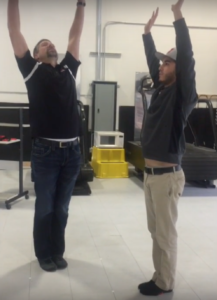by Mitch Hauschildt, MA, ATC, CSCS
This past weekend, I had the pleasure of teaching Neurofacilitation for Better Movement in the Salt Lake City, Utah area to a group of really fun, bright and enthusiastic fitpros and clinicians. We had a ton of fun in that course, sharing how the brain can and does change how we move.
One of the activities that I have used a lot in my courses over the years is a standing toe touch and how in the right person, we can help someone to touch their toes by improving core and trunk stability, rather than stretching. If someone doesn’t have the ability to touch their toes in standing, but can in seated tells us that they have the mobility to touch their toes, but when they stand and need to stabilize their pelvis, they use their hamstrings and hip flexors to stabilize instead of their deep trunk stabilizers. This activity is a great way to illustrate the close relationship between mobility and stability and shows how important it is to perform a thorough evaluation under a lot of different conditions.
Usually, I use a diaphragm taping technique or multisegmental rolling to improve trunk stability, as they are very dependable. After doing this a long time, as long as I pick the correct person based on a quick evaluation, it works every time. As an instructor, it is one of my favorite things to show, because it is much more important to people to be able to touch their toes than most people realize. Thus, it is a very powerful demonstration. And, it is a “light bulb” type of moment for a lot of people when they see it for the first time. I have even had people tell me that by me helping them touch their toes, it has saved their marriage. I think that is a bit over-the-top, but regardless, it is a big deal to a lot of people.
This time around, I performed the activity as I always do, but I chose a different technique to improve the toe touch…breathing, reaching and speaking. We caught in on tape here:
Notice how the course attendee gained at least 3 inches on his toe touch in a matter of a couple of minutes. I promise that we didn’t perform any stretching and I had never met this gentleman before the seminar to set anything up. So, why did it work?
The simple answer is…Neurofacilitation.
Its all about changing movement by changing the way that the nervous system speaks to the body.
The basic premise of the activity goes like this:
I identified him as someone who lacked basic trunk stability by having him touch his toes both standing and sitting. His results were inconsistent. He was about 3 inches from the floor in standing, but could get to the tops of this toes in a seated position. He was the only one in the small class who demonstrate this, so he was my winner to participate.
The rest of it is simple. If you introduce trunk stability, he will touch his toes. And, he did.
But, how does breathing, reaching and speaking improve trunk stability?
First, I decided to do a quick reset of his nervous system in the form of diaphragmatic breathing. The diaphragm is very important to the nervous system and can do a lot to control our sympathetic and parasympathetic response. I was a bit nervous that his long time dysfunction would cloud my intervention if I went right to reaching and speaking, so I had him lie flat and breath through his belly for about a minute to calm the nervous system and reset it a bit. This gave me a clean slate to start from (or at least closer to a clean slate than when he walked in the door).
Then, it was all about up regulating his sympathetic nervous system. That is our “fight or flight” mode and is a rather primal response for our body. The theory is that if we up regulate the sympathetic response that our body will automatically improve tone and stability has it prepares to fight or flight.
I accomplished a sympathetic response with 2 things: reaching and speaking. Reaching tall towards the sky is known to a lot of psychologists to improve our thoughts and mood which is a step in the right direction. Reaching also puts the trunk under tension, which encourages the natural increase in muscle tone that I was looking for. Finally, he began speaking what he wanted to do. I do think that there is something to the positive affirmation that took place while he was telling himself what he wanted to do, but the more important part was his tone and volume. With each rep that he stated “I will touch my toes”, he said it louder and with greater authority. And with each rep, he elevated his sympathetic nervous system’s response.
After a few reps of reaching and speaking, you can see how he did. He touched his toes for the first time since he was in elementary school. He and the class loved it! He facilitated his nervous system in such a way that he improved how he moves.
The last question is…now what?
That’s fairly simple also. He needs to exercise in his new range of motion so his brain understands that it is safe to go there and he needs to improve the function of his deep trunk stabilizers to improve timing, sequencing and rhythm.
The brain reigns supreme. The better we understand it, the better our interventions will be.


Leave a Reply